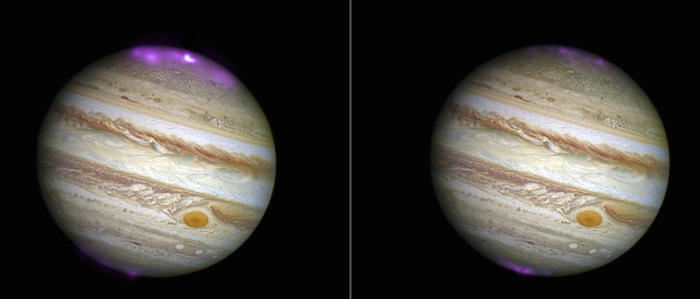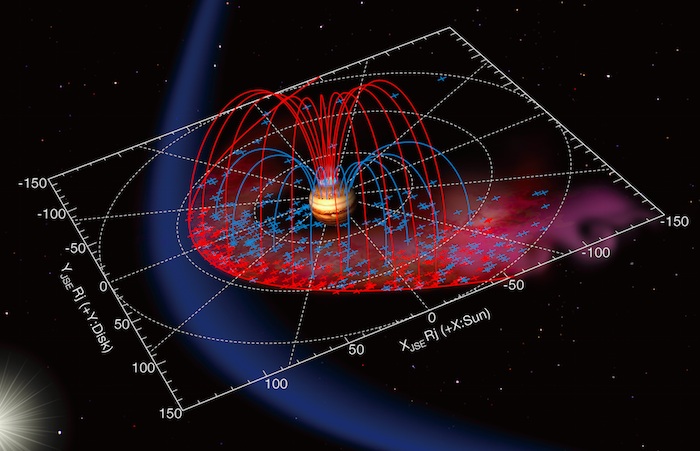.
24.03.2016
A new study shows the interaction with Jupiter's magnetosphere when giant solar storms arrive at the planet.
.

CREDIT: X-RAY: NASA/CXC/UCL/W.DUNN ET AL, OPTICAL: NASA/STSCI
Solar storms trigger X-ray aurorae on Jupiter that are about eight times brighter than normal, a new study has found using data from NASA’s Chandra X-ray Observatory.
It is the first time that Jupiter’s northern and southern lights have been studied in X-ray light when a giant solar storm arrived at the planet.
The aurorae are hundreds of times more energetic than those on Earth and cover an area greater than the surface of the Earth.
While the Sun constantly ejects streams of particles in a so-called solar wind, causing aurorae on Jupiter, this becomes much stronger during a solar storm, or coronal mass ejection.
The stronger wind pushes Jupiter’s magnetosphere (the region of space controlled by the planet's magnetic field) inward by nearly two million kilometres, and the study found that the interaction at this boundary triggers the X-rays in Jupiter’s auroras.
The composite images above show Jupiter and its aurora during and after the arrival of particles from a giant coronal mass ejection in October 2011. X-ray data from Chandra (purple) is overlaid on an optical image from the Hubble Space Telescope.
On the left, we can see the X-ray activity when the coronal mass ejection reaches Jupiter. The image on the right shows what is happening two days later after the coronal mass ejection has subsided.
Scientists took the snapshot by monitoring X-rays emitted during two 11-hour observations, using the data to pinpoint the source of the X-ray activity.
Quelle: COSMOS
.
Update: 26.03.2016
.
Solar Wind Induces Jupiter’s X-ray Aurora

Artistic rendering of the Jupiter’s aurora and magnetosphere. [Click for large image]
-
Jupiter boasts some of the most powerful aurora in the solar system. Compared to the Earth’s aurora, it is a few hundred times more powerful and brighter in the all spectrum range. What causes Jupiter’s powerful aurora? Several hypotheses have been proposed, but it has remained a mystery due to a lack of observational evidences.
Jupiter’s X-ray aurora, which is observed in the X-ray spectrum region, is thought to sparkle when oxygen and sulfur ion particles moving at nearly the velocity of light strike the Jupiter’s atmosphere. How can these ions be accelerated to such high speed? There are two leading hypotheses. The first one assumes that the solar wind speeding up the ions, similar to the case of the Earth’s aurora. The other proposes that the ions are being accelerated by the rapid spin of the Jupiter, the Jupiter’s own magnetic field and plasma provided by the Jupiter’s satellite Io.
Monitor observations of the Jupiter’s X-ray aurora are essential to compare several parameters of the X-ray aurora, such as brightness at each location, with the changes in the solar wind. For example, a correlation between the solar wind and the X-ray aurora supports the first hypothesis (the ions are accelerated by the solar wind) observationally.
Using the Spectroscopic Planet Observatory for Recognition of Interaction of Atmosphere "HISAKI" (SPRINT-A), the Chandra X-ray Observatory and X-ray Multi-Mirror Mission (XMM-Newton), scientists monitored the Jupiter’s X-ray aurora for two weeks in April 2014.
“We estimated the variation of the solar wind at Jupiter by HISAKI’s data. The data of the solar wind at the Earth was available. However, when this observation was conducted, Jupiter was in particular far from the Earth. The estimated pressure and velocity of the solar wind at the Jupiter location is much less accurate if we extrapolated these values observed at the Earth.” Kimura, the research team lead, explains. The results show the strong correlation between the velocity of the solar wind and the strength of the X-ray aurora. Although previous studies indicated the correlation between the pressure of the solar wind and the strength of the X-ray aurora, this is the first time to show the velocity of the solar wind affects the strength of the X-ray aurora. Since the Jupiter’s aurora at other spectral range is thought to get kicked off by the planet-moon interaction, not by solar activity, this study suggests the X-ray aurora sparks by different mechanism from the Jupiter’s aurora emitting light in other wavelength ranges.
Kimura continues, “We observed the X-ray aurora for 10 hours once-daily, 6 times in total. Thanks to the high resolving power of the Chandra X-ray observatory, we could obtain the detailed spatial structure and its time variations of the X-ray aurora. The spectral data taken by the XMM-Newton told us the volcanic gases from the satellite Io and oxygen atoms can exist in the solar wind emit X-ray. “
.

Spatial distribution of the magnetic flux line of the X-ray aurora at the Jupiter’s magnetosphere. [Click for large image]
-
The long-time observation by the Chandra also elucidated the fine spatial structure of the X-ray aurora and precise measurement of time variations. Kimura says, “Using the observational data and a numerical model of the Jupiter’s magnetic field, we studied the spatial distribution of the magnetic flux line of the X-ray aurora at the Jupiter’s magnetosphere. Our estimation shows the lines of magnetic force piercing the X-ray aurora connect with the boundary surface between the Jupiter’s magnetosphere and the solar wind. Together with this and the correlation between the velocity of the solar wind and the strength of the X-ray aurora, we believe the solar wind causes the X-ray aurora.”
Another study out today, led by William Dunn from UCL and co-authored by the JAXA research team also analyzed the X-ray data taken in 2011. Despite the complete difference in condition of the solar wind observed in 2014, the team found the similar trends, i.e., the correlation between the solar wind and the strength of the X-ray aurora, and the lines of magnetic force connected with the outer region of the Jupiter’s magnetosphere. These are consistent with the results based on the observations in 2014.’
So you are aware, we’ve included the following paragraph in our release about Tomoki’s paper (as well as including a full list of authors and bibliographic information of the paper):
‘Another study out today, led by Tomoki Kimura from the Japan Aerospace Exploration Agency (JAXA) and co-authored by the UCL researchers, reports that the X-ray aurora responds to quieter ‘gusts’ of solar wind, deepening this connection between Jupiter and the solar wind.’
Observation by HISAKI and the Hubble Space Telescope in January 2014 focused on precipitations of the Jupiter’s aurora in UV. This research concluded the Jupiter’s high spin resulted in the precipitations of the UV aurora. The results of the X-ray and UV aurora suggest that the both mechanisms, the Jupiter’s rapid spin and the solar wind, cause the Jupiter’s powerful aurora phenomenon.
Yamazaki, the HISAKI project manager tells, “Auroras in atmospheres of other planets can be formed by the mechanisms similar to the Jupiter. For example, there is a high possibility of similar phenomena in the atmosphere of Saturn, because plasma particles originated from water of the Saturn’s satellite Enceladus are captured by the Saturn’s magnetic field and turn rapidly around the Saturn. Of course, auroras can form in the atmosphere of an exoplanet. In some day, our research may apply to study aurora phenomena of exoplanets.“
Kimura tells about his future researches as follows, “We plan further observations of the Jupiter’s auroras by the X-ray Astronomical Satellite “HITOMI” (ASTRO-H) and JUNO probe which will perform a polar orbit insertion. By using HISAKI’s data complementary, we would like to understand the acceleration mechanism of particles inducing the Jupiter’s aurora phenomena. “
Quelle: JAXA4560 Views
